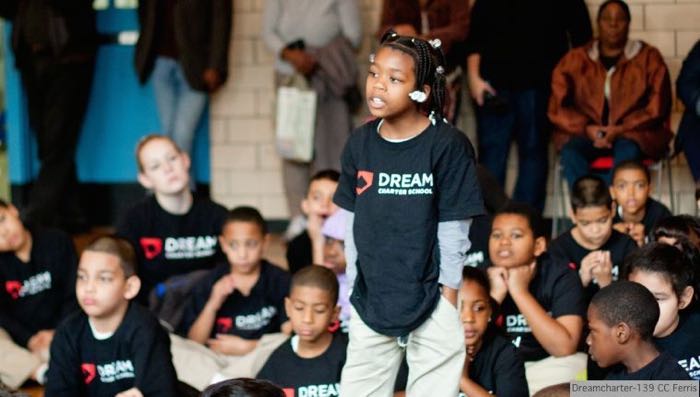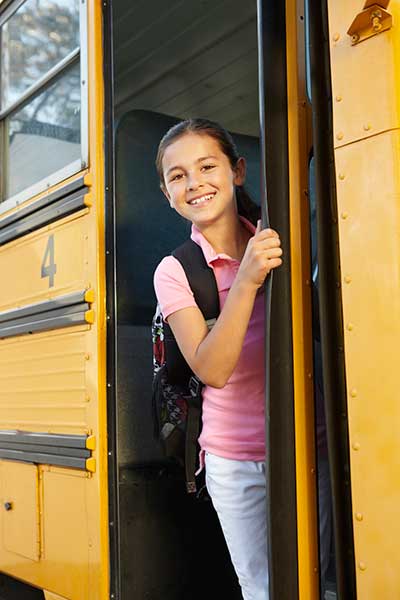
The world's most famous school is imaginary. The Harry Potter series features a school with tremendous culture — and a sorting hat.
In This Lesson

Why does school climate matter?
What makes a school climate good or bad?
How can we improve our school climate?
How is school climate measured?
What are the California School, Health, and Learning Climate Surveys (CSCHLS)?
What is a funding mandate in California?
Do school uniforms help students learn?
▶ Watch the video summary
★ Discussion Guide
At real schools, students tend to separate themselves into groups even without a magic hat. The cool kids hang out in this hallway. Academic kids go to that one. The kids who speak Spanish tend to assemble over here. Kids into sports tend to gather over there.
To unify a group is hard, especially to do so in ways that respect and celebrate differences. School works better when each student is included and motivated but it doesn't just happen. Great teachers succeed partly by creating a culture that "works" for learning in their classrooms. Great schools create a culture of learning greater than any individual class or grade level.
A climate of learning
The National School Climate Center defines school climate as "the quality and character of school life." California has enshrined attention to school climate as a required topic for annual review of each school district’s Local Control Accountability Plan (LCFF Priority 6).
The California State Board of Education (SBE) has helpfully created a set of Model Practices to clarify the systemic components of building and sustaining a positive school climate. Here’s an abbreviated summary of those practices, emphasizing questions you can ask in your own district or school:
|
Topic |
Questions to ask in your school or district |
|
|---|---|---|
|
1 |
Implement a School Climate Improvement Process. |
Is there a task force or committee focused on improving school climate? How is this group’s work defined, supported, shared and celebrated? |
|
2 |
Conduct a School Climate Survey |
What are you measuring, and how frequently? Are you using the California School Climate, Health, and Learning Survey (CAL-SCHLS)? How are findings used? How are students part of the process? |
|
3 |
Build Capacity for Staff Support and Wellness |
How are leaders trained to develop climate intentionally? What processes are in place for mentorship? |
|
4 |
Support students’ sense of engagement and safety |
How is the district investing to identify student needs and respond to them proactively (MTSS)? What is the strategy to prevent and mitigate bullying? What partnerships does the district rely on, and are they effective? Who serves as Ombudsperson? |
|
5 |
Strengthen School, District, and Community Relationships. |
What is the role of the parent liaison? How do school communities connect and learn from one another? How would these connections be deployed in a crisis? |
|
6 |
Provide a Supportive and Engaging Physical Environment. |
Who is involved in making the “place” of school safe, inviting and effective? If something is wrong or missing, what’s the process to address it? |
|
7 |
Adopt Positive Disciplinary Measures |
What underlying issues drive behavior problems and conflict? What goals make sense to guide discipline policies, and how will the plans to meet those goals be developed and shared? Consider PBIS, Restorative Practices, and Youth Court programs. |
Elements of school climate
'Bully-victim behavior' is a public health problem affecting up to a quarter of students every year.
A sizable body of research backs up the common sense observation that school climate matters, and that there are things you can do to develop it intentionally. Some strategies are implied in the questions above; The National School Climate Center has a lot more, organized in a kind of pick-what-you need menu of strategies and interventions. Among them, the following stand out:
- Take attendance seriously. When a student doesn’t come to school, something is wrong. It might be an individual issue, but it might also point to deeper problems with the culture of the school community. We dig into the issue of attendance more in Ed100 lesson 4.8. Because of the way school funding in California works, effective investments that improve attendance essentially pay for themselves.
- Take bullying seriously. When kids don’t feel safe at school, learning is hard. Although physical assault is rare in most schools, bullying is common and corrosive, and the effects can be long-lasting. According to the 2024 School Crime Supplement of the national Crime and Safety Survey, approximately 22% of students ages 12-18 reported being bullied at school, with cyberbullying affecting an additional 15% of students. A lot of bullying goes unreported, especially in schools with a culture that demonizes "tattle-tales" or "snitches." It's hard to feel sympathy for bullies, but they warrant attention, too. Bullying behavior strongly predicts future trouble with the law, among other things.
- Invest in relationships. School is personal. Students may or may not love the subject matter of a class, but they decide quickly and intuitively whether teachers care about them and whether they care about their peers. Teacher absenteeism and turnover are measurable warning signs of troubled relationships in a school climate.
- Take learning seriously. Successful schools make learning the central activity, and support teachers to make it so.
- Light up the dark spots. Bad things happen less often in spaces that are supervised. (For more about safety and school discipline, see Ed100 lesson 5.13.)
A student's sense of safety and belonging is often correlated with facets of their social identity. Research by WestEd on school climate suggests that students of color tend to feel less safe and included at school than their white peers do.
Measuring school climate
Under the right conditions, school climate surveys can spark discussions that lead to insights and action. In order for surveys to perform this function usefully, however, they must be used. Someone with credibility in the school community has to assemble the data and inspire people to take the time to look. Results must be delivered promptly in ways that are clear and relevant, or they will simply be ignored. This is hard to do.
In California, the most widely-used survey that relates to school climate is the California Healthy Kids Survey (CHKS), a component of the broader California School Climate, Health, and Learning Surveys (CSCHLS). Many California districts have some long-ago experience with these surveys because they were briefly supported by federal Title IV funding in the 2008-09 school year. When this source of funding dried up, the survey became one of the many things that school districts can decide to invest in (or not) as part of the very flexible funds they receive under the Local Control Funding Formula (LCFF). Lessons learned from this very successful experiment can provide inspiration and insights for school districts. It’s a valuable read.
School climate surveys and the LCAP
School climate surveys: recommended, but not required
California school districts are obligated to include information about school climate as part of their Local Control Accountability Plan (LCAP). They are not, however, obligated to collect data in any particular way. The Healthy Kids (CHKS) and School Climate (CSCS) surveys provide an obvious mechanism to deliver on that requirement, so some school districts continue to use the Healthy Kids Survey or alternatives based on it. There is no known data about which use it and which do not.
Ironically, while these surveys are about students, they don’t actually survey students directly. They could. For example, the National School Climate Center offers surveys that include students. Ed100 Lesson 2.10 explores practical approaches and some hints about wording.
Not a mandate, just a suggestion
A 2018 report by Fight Crime: Invest in Kids found that state guidance about school climate surveys is often ignored. The state of California has no mechanism to collect information from school climate surveys that are conducted in each district. Why? Because doing so would constitute a state mandate — and state mandates have to be state funded. More about state mandates in Ed100 Lesson 7.3.
School uniforms
Education reform priorities can change over time. For example, in the 1990s, there was a lot of serious conversation about school uniforms as an essential ingredient of a school improvement strategy. Many private schools have long required pupils to wear them — are they onto something?
In the early 1990s, California’s Long Beach Unified became America’s first public school district to require (and provide) uniforms for its students. The students’ strong improvement in academic performance drew national attention, and in a period of a decade thousands of schools adopted them. The uniforms create a visible shared identity among schoolmates, and reduce the visibility of wealth differences. Not everyone agrees, of course — for example, some feel that uniforms are an unnecessary expense, and that they inhibit personal expression. As of 2021-22, nearly a fifth of public school districts in America required uniforms, Long Beach still among them.
In part, uniforms are a strategy to reduce bullying based on visible clues about poverty. Uniforms also can play a role in reducing gang identification in schools. California law permits schools to establish uniforms, but requires schools to help economically disadvantaged students pay for them.
Did this great debate reveal that uniforms are a magic solution to urban school improvement? Of course not. There is no automatic connection between what kids wear and what they learn. Does that necessarily mean that uniforms are a dumb idea? No, it's just an incomplete idea. Implementing uniforms can create a sudden and visible change in a school environment, but it is up to the school’s leaders and faculty to create the less visible changes that drive student learning. Arguments and claims on all sides are summarized here by Public School Review and discussed more extensively by Greatschools.org.
The next lesson explores one of the major recurring themes of school reform: small schools.
Updated October 2025
CHAPTER 5:
Places For Learning
-
Places For Learning
Overview of Chapter 5 -
Where Are the Good Schools?
Zip Codes and School Quality -
School Choice
Policies for Placing Students -
Selective School Programs
How Schools Sort Students -
Continuation Schools
When Regular School Doesn't Cut It -
Charter Schools
Public Schools, Different Rules -
Private Schools
Tuition, Vouchers, and Religion -
Community Schools
Services Beyond Classwork -
Principals and Superintendents
The Pivotal Role of an Educational Leader -
School Facilities
What Should a School Look Like? -
School Climate
What Makes a School Good? -
Small Schools
Are They Better? -
Home Schools
How Do They Work? -
School Discipline and Safety
Suspensions and Other Options
Related
Sharing is caring!
Password Reset
Search all lesson and blog content here.
Login with Email
We will send your Login Link to your email
address. Click on the link and you will be
logged into Ed100. No more passwords to
remember!














Questions & Comments
To comment or reply, please sign in .
Jeff Camp - Founder October 24, 2025 at 8:14 am
Carol Kocivar April 26, 2023 at 7:34 pm
A new analysis of California Healthy Kids Survey (CHKS) results from 2017–19 shows that lesbian, gay, bisexual, transgender, queer, and questioning (LGBTQ) secondary students are at higher risk for bullying and victimization, chronic sadness, suicide ideation, and poor learning engagement and academic performance than their straight and non-transgender counterparts.
They also are likely to receive substantially fewer social and developmental supports from teachers and are less likely to feel safe at school.
https://bit.ly/40h6nRT?mkt_tok=NjgyLURCVS04MDkAAAGLFMFi7FhR4TZ078c9dvtEdyFAXX_wyD8IUEknKmliNbLTM6Cq8X8xmgaHzc4suff_LfP_yS1VSK_O4O3ZPAx7tnFJnQZ62qerDrj-HKModA
Group differences are generally greater among middle school students than high school students.
Jeff Camp - Founder September 27, 2021 at 10:10 pm
Jeff Camp February 14, 2017 at 9:57 pm
Jeff Camp December 16, 2016 at 4:23 pm
sfritts9 April 29, 2015 at 5:43 am
Tara Massengill April 20, 2015 at 2:31 pm
irma.i.brito April 16, 2015 at 12:15 pm
Robert Crowell May 4, 2018 at 9:13 am
trckrnnr April 2, 2015 at 12:53 pm
Mamabear March 20, 2015 at 4:55 pm